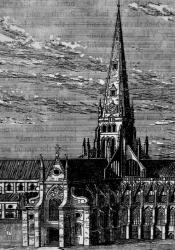The Great Fire of London 1666 (Historical)
The Great Fire of London (Historical) was an uncontrollable fire that swept through the City of London for 5 days destroying historical English landmarks such as St. Paul's Cathedral and the Royal Exchange as well as over 13,000 homes. Within Virginia Woolf's Orlando, Orlando subtly hints at this tragedy by first referencing the English Civil War (1642-1651) and then a fire that had occurred afterwards under King Charles II's reign; "But the revolution which broke out during his (King Charles II) period of office, and the fire which followed, have so damaged or destroyed all those papers..." (Woolf 65). According to author Walter George Bell in his book The Great Fire of London; “Restoration London was densely overcrowded, ever after the Plague had reduced the numbers. The wars being ended and the armies disbanded, old soldiers came to the metropolis,” (Bell 9); moreover this was a transitional period for London on the eve of the Industrial Revolution where timber frames were replaced with brick and factories polluted the air. In Orlando, Woolf uses the landmarks destroyed by the Great Fire to show how time within the novel and England is rapidly changing in the wake of the Industrial Revolution and Victorian Era as English society regressed.
Woolf, Virginia. Orlando: A Biography. Harcourt Brace Jovanovich, 1992.
Bell, Walter George. The Great Fire of London, by Samuel Pepys, Penguin Classics, 2015, pp. 1–10.

